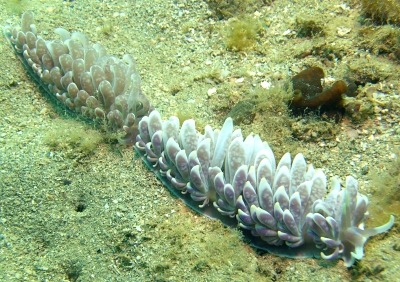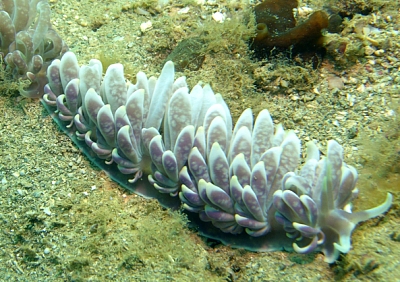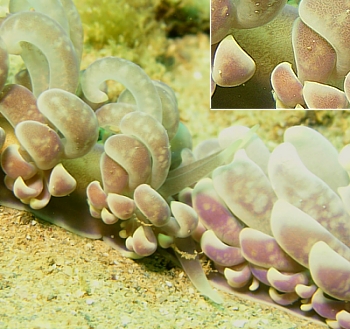Phyllodesmium magnum - trailing observation
September 5, 2006
From: Jean-François Hervé


Here is another species I recently observed trailing. Trailing is a really curious behavior. Few animals are able to do that (like an elephant?!). Dave Behrens in his book (Nudibranch Behavior) explain the mucus role. Find a friend (same species) in the sea appears to me to be a difficult task and when you find one you must keep it.
Locality: Noumea, 7 m, New caledonia, Pacific Ocean, August 06. Length: 8+6 cm. Photographer: Jean-François Hervé.
Dr Rudman, do you know how they find partners?
Thank you.
Jean-François Hervé
jfherve@free.fr
Hervé, J.F., 2006 (Sep 5) Phyllodesmium magnum - trailing observation. [Message in] Sea Slug Forum. Australian Museum, Sydney. Available from http://www.seaslugforum.net/find/17721
Dear Jean-François,
Thanks for this interesting observation. We are building quite a list of species on the Trailing page. This is the second record we have of this aeolid, Phyllodesmium magnum, trailing. At such a size it must be quite a spectacular sight. The other record is Binyamin Koretz's [message #14655] from the Red Sea.
As I have discussed elsewhere, we aren't really sure why this form of close trailing - head on tail - occurs. Those species of aglajids such as Navanax inermis, which feed on other opisthobranchs, certainly follow mucus trails in search of prey, and at times end up eating their own kind. Related species, such as Chelidonura varians, feed on flatworms, but also exhibit this trailing behaviour. I can understand that following mucus trails of your own species could be useful in finding a mate to breed with or even a source of food, but I can't see why some species have developed this extreme behaviour of not even losing touch with their 'friend'. Perhaps finding a mate is so difficult for these species that they can't afford to literally lose touch.
You ask how opisthobranchs normally find partners. Although many species use their chemosensory rhinophores to find their food, I know of no studies to show they can find partners by waterborne chemicals, except for the fairly recent discovery of a 'love drug' in Sea Hares which I mentioned a few days ago [message #17419] which seems to attract sea hares to others of their own kind who are egg-laying. It's possible that there are other waterborne signals for other opisthobranchs but at present it seems they meet either by chance, usually as an aggregation at a food item. We clearly have much to learn.
I am not sure if you kow that Phyllodesmium magnum is a solar-powered slug, obtaining much of it nutreint requirements from the microscopic plants [zooxanthellae] in its tissues. I have included a close-up inset in the photo alongside. The brown specks you can see in the skin are the zooxanthellae.
Best wishes,
Bill Rudman
Related messages
-
Phyllodesmium from Lembeh, Indonesia
From: Brian Mayes, March 2, 2009 -
Phyllodesmium magnum from Nhatrang, Vietnam
From: Hua Thai Tuyen, June 5, 2008 -
Re: Phyllodesmium magnum on Sinularia
From: Gary Cobb, April 4, 2008 -
Re: Phyllodesmium magnum on Sinularia
From: Gary Cobb, April 4, 2008 -
Phyllodesmium magnum juveniles
From: Gary Cobb, April 3, 2008 -
Re: Phyllodesmium magnum on Sinularia
From: Gary Cobb, April 3, 2008 -
Phyllodesmium magnum on Sinularia soft coral
From: David Mullins, October 17, 2007 -
Phyllodesmium magnum pair from the Red Sea
From: Binyamin Koretz, October 13, 2005 -
Phyllodesmium magnum from Elat, the Red Sea
From: Matan Ninio, April 13, 2005 -
Re: Phyllodesmium magnum from Thailand
From: Paul Whitehead, January 25, 2004 -
Re: Phyllodesmium magnum from Thailand
From: Paul Whitehead, January 23, 2004 -
Phyllodesmium magnum on Sinularia
From: Cameron Bee, January 17, 2003 -
Phyllodesmium magnum from the Marshall Islands
From: Scott Johnson, September 11, 2002 -
Unknown reef tank inhabitant
From: Dean Burchell, July 23, 2002 -
Reef Tank Hitchhiker
From: Mike Nolette, May 21, 2002 -
Phyllodesmium magnum - size?
From: Valda Fraser, April 10, 2002 -
Food of orange Phyllodesmium magnum
From: Leslie Chan, September 11, 2001 -
An orange Phyllodesmium magnum from Hong Kong
From: Leslie Chan, September 9, 2001 -
Phyllodesmium magnum from Queensland
From: Nigel Holmes, July 10, 2001 -
Phyllodesmium magnum from South Africa
From: Valda Fraser, May 26, 2001 -
Phyllodesmium magnum from Hong Kong
From: Bernard Picton , March 4, 2001 -
Phyllodesmium magnum from Japan
From: Yasuhiro Shirai, November 23, 1999
